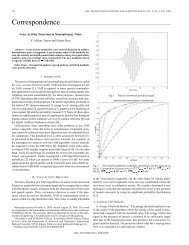Thesis (PDF) - Signal & Image Processing Lab
Thesis (PDF) - Signal & Image Processing Lab
Thesis (PDF) - Signal & Image Processing Lab
Create successful ePaper yourself
Turn your PDF publications into a flip-book with our unique Google optimized e-Paper software.
28 CHAPTER 2. THEORETICAL BACKGROUND<br />
central regions in those images are characterized by the sequences {+1, −1, 0, . . .} and<br />
{+1, +1, 0, . . .}, respectively, whose infimum is given by {+1, 0, . . .}. The supremum<br />
f △ g, on the other hand, does not exist in this case.<br />
Figure 2.6: (a)-(b) Two grayscale images, and (c) their infimum according to ⊑. The<br />
supremum does not exist in this case.<br />
Here is another way of understanding why the binary case lends itself to a lattice<br />
framework: Binary images are represented by alternating binary sequences starting<br />
with +1. These are fully characterized by their length alone, and are completely<br />
ordered.<br />
Even though working with an inf-semilattice means that dilations can not be<br />
defined in all cases, the inf-semilattice theory described in [4, 5] assures that a great<br />
deal can be accomplished nevertheless. Not only can erosions be defined, but also<br />
openings, internal gradients, white top-hats, skeletons, openings by reconstruction,<br />
etc.<br />
Let us define the translation-invariant erosion:<br />
ˆεS(f) = U −1 � ▽ y∈ ˇ SU{fy} � , (2.16)<br />
where fy denotes the translation of f by y: fy(x) = f(x − y). Fig. 2.7 shows an<br />
example of using the above “shape erosion” on a gray-scale image, compared to using<br />
the standard gray-scale erosion.<br />
The adjoint dilation is given by<br />
ˆδS(f) = ▽{g | f ⊑ ˆεS(g)}, (2.17)
















